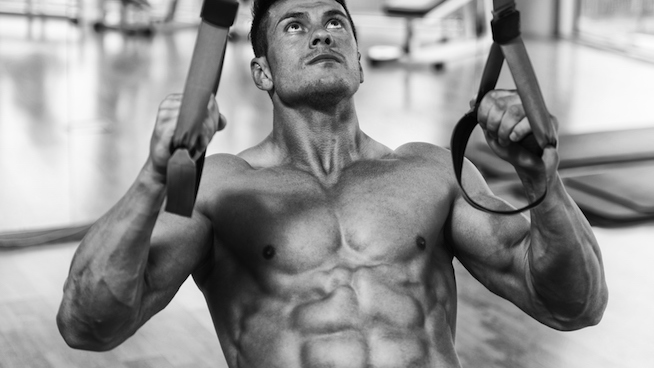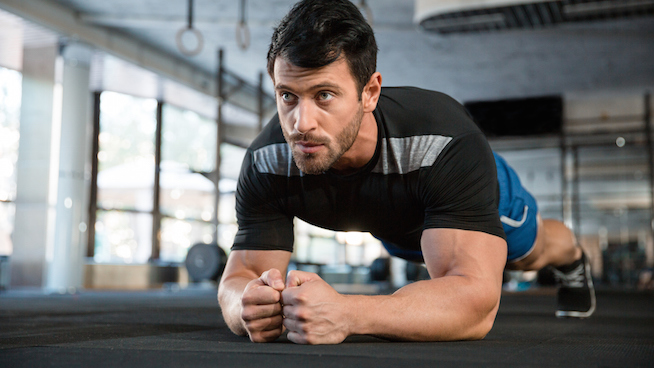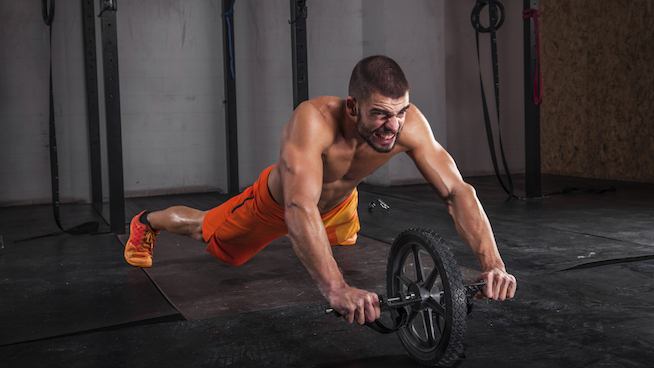Why Doing Your Core Training at the End of Your Workout is Not the Best Approach
If you want to rearrange your workout, an organization is certainly important. You don’t want to dive headfirst into heavy lifts without a warm-up, but you also don’t want to burn yourself out before your most important exercises. One common workout formatting strategy? Saving core work for the end.
The basic weight room workout seems to follow this order: warm-up, big lifts, accessory exercises, core work. You’ve probably performed a hundred workouts following that basic format, and you’ve always saved core work until the end. But just because something’s the norm doesn’t necessarily mean it’s right. Here’s why you need to re-think the way you approach core training.
The Strongest Link

Your core, commonly defined as the collection of muscles around your lower back and midsection, might be the single most important area of your body when it comes to athletic performance.
If you think of your body as a giant chain, your core is the center link that holds everything together. Without a strong and stable core, power cannot be adequately transferred through the body, and this has a negative impact on performance.
Pro Bowl tight end Travis Kelce summed it up best. “Your core is like your engine. It triggers everything and gets everything going,” Kelce told STACK. “Guys can be as big as they want, but if they’re weak in the core, they’re not going to be a good football player.”
RELATED: 5 Core Exercises That Will Make You a Better Athlete
So if a strong core is so important, why is it saved for the finale of the workout? Wouldn’t it make sense to tackle this key area when you’re fresh and spry instead of tired and depleted? To answer that question, you need to understand that the category of “core training” is broader than you believe.
Core Training Is Broader Than You Think

Core training is commonly thought of as involving exercises that focus primarily on the core. This makes sense, since the core as an “engine” means it plays a big role in nearly all movements.
Free weight movements like Squats, Deadlifts, Lunges, Hang Cleans, Military Presses—all require a good amount of core activity to be performed properly.
“For me, the core consists of everything excluding the limbs. We could make the case that the core is being trained the entire session no matter what,” says Tony Gentilcore, co-founder of Cressey Performance.
Many of the free weight lifts you perform during your workout recruit muscles in your core—even if you think of them more as upper- or lower-body exercises. When you remember that your core plays a pivotal role in stabilizing your body and allowing you to perform weighted movements in space, this makes sense.
Start Your Engine

Since an active core is a key for proper form during free weight lifts, it does make sense to perform exercises that focus on activating your core early in your workouts.
According to Ben Boudro, owner of Xceleration Sports, performing some core work at the beginning of a workout activates the muscles you need to lift heavy weights with proper form. “We emphasize our athletes first engaging their core then moving their limbs while maintaining a solid core position. This gets their brains wired for the entire workout and minimizes sloppy form,” Boudro says.
The National Academy of Sports Medicine offers a great explanation of why performing core-centric exercises toward the beginning of a workout is beneficial to performance:
“We strongly recommend performing some ‘core’ work near the beginning of your workout after stretching and a light aerobic warm-up. This method prepares your core for the rest of your workout. Regardless of what body part you are training (chest, back, legs, etc.) or what type of exercise you’re performing, your core plays a pivotal role to help you maintain proper posture and protect your spine. Performing a few core exercises (for example 1 to 3 exercises) will help ‘wake up’ your nervous system and enable you to contract your core muscles (abdominals, low back and gluteals) forcefully during your workout. When your core muscles are operating optimally, you’re able to move more efficiently, enhance your workout and prevent injury. It is important to note that you shouldn’t perform a high volume of core exercises that fatigue your core. The object is to simply ‘wake up’ these muscles.”
Think of early-session core exercises as firing up your engine. Once you get your core activated and running smoothly, you’re ready to put the pedal to the metal in your workout.
The Sweet Spot

Performing a couple of core-centric exercises prior to your big lifts ensures your core is activated and ready to help you move properly. But it’s a fine line. Completely fatiguing your core at the start of a workout could leave nothing in your tank for the rest of the session. Boudro recommends choosing one or two of the following exercises and performing them directly after your warm-up to get your core fired up and ready to support your workout.
- Front Planks w/ Reach
- Pallof ABCs
- Bird Dogs
These exercises will prime your core for your big lifts without fatiguing it to a point that could negatively affect your performance. Later in your workout, you can hit a few more core-centric exercises to build strength and stability.
RELATED: Quit Doing Crunches: Here’s the Real Best Way to Train Your Core
RECOMMENDED FOR YOU
MOST POPULAR
Why Doing Your Core Training at the End of Your Workout is Not the Best Approach
If you want to rearrange your workout, an organization is certainly important. You don’t want to dive headfirst into heavy lifts without a warm-up, but you also don’t want to burn yourself out before your most important exercises. One common workout formatting strategy? Saving core work for the end.
The basic weight room workout seems to follow this order: warm-up, big lifts, accessory exercises, core work. You’ve probably performed a hundred workouts following that basic format, and you’ve always saved core work until the end. But just because something’s the norm doesn’t necessarily mean it’s right. Here’s why you need to re-think the way you approach core training.
The Strongest Link

Your core, commonly defined as the collection of muscles around your lower back and midsection, might be the single most important area of your body when it comes to athletic performance.
If you think of your body as a giant chain, your core is the center link that holds everything together. Without a strong and stable core, power cannot be adequately transferred through the body, and this has a negative impact on performance.
Pro Bowl tight end Travis Kelce summed it up best. “Your core is like your engine. It triggers everything and gets everything going,” Kelce told STACK. “Guys can be as big as they want, but if they’re weak in the core, they’re not going to be a good football player.”
RELATED: 5 Core Exercises That Will Make You a Better Athlete
So if a strong core is so important, why is it saved for the finale of the workout? Wouldn’t it make sense to tackle this key area when you’re fresh and spry instead of tired and depleted? To answer that question, you need to understand that the category of “core training” is broader than you believe.
Core Training Is Broader Than You Think

Core training is commonly thought of as involving exercises that focus primarily on the core. This makes sense, since the core as an “engine” means it plays a big role in nearly all movements.
Free weight movements like Squats, Deadlifts, Lunges, Hang Cleans, Military Presses—all require a good amount of core activity to be performed properly.
“For me, the core consists of everything excluding the limbs. We could make the case that the core is being trained the entire session no matter what,” says Tony Gentilcore, co-founder of Cressey Performance.
Many of the free weight lifts you perform during your workout recruit muscles in your core—even if you think of them more as upper- or lower-body exercises. When you remember that your core plays a pivotal role in stabilizing your body and allowing you to perform weighted movements in space, this makes sense.
Start Your Engine

Since an active core is a key for proper form during free weight lifts, it does make sense to perform exercises that focus on activating your core early in your workouts.
According to Ben Boudro, owner of Xceleration Sports, performing some core work at the beginning of a workout activates the muscles you need to lift heavy weights with proper form. “We emphasize our athletes first engaging their core then moving their limbs while maintaining a solid core position. This gets their brains wired for the entire workout and minimizes sloppy form,” Boudro says.
The National Academy of Sports Medicine offers a great explanation of why performing core-centric exercises toward the beginning of a workout is beneficial to performance:
“We strongly recommend performing some ‘core’ work near the beginning of your workout after stretching and a light aerobic warm-up. This method prepares your core for the rest of your workout. Regardless of what body part you are training (chest, back, legs, etc.) or what type of exercise you’re performing, your core plays a pivotal role to help you maintain proper posture and protect your spine. Performing a few core exercises (for example 1 to 3 exercises) will help ‘wake up’ your nervous system and enable you to contract your core muscles (abdominals, low back and gluteals) forcefully during your workout. When your core muscles are operating optimally, you’re able to move more efficiently, enhance your workout and prevent injury. It is important to note that you shouldn’t perform a high volume of core exercises that fatigue your core. The object is to simply ‘wake up’ these muscles.”
Think of early-session core exercises as firing up your engine. Once you get your core activated and running smoothly, you’re ready to put the pedal to the metal in your workout.
The Sweet Spot

Performing a couple of core-centric exercises prior to your big lifts ensures your core is activated and ready to help you move properly. But it’s a fine line. Completely fatiguing your core at the start of a workout could leave nothing in your tank for the rest of the session. Boudro recommends choosing one or two of the following exercises and performing them directly after your warm-up to get your core fired up and ready to support your workout.
- Front Planks w/ Reach
- Pallof ABCs
- Bird Dogs
These exercises will prime your core for your big lifts without fatiguing it to a point that could negatively affect your performance. Later in your workout, you can hit a few more core-centric exercises to build strength and stability.
RELATED: Quit Doing Crunches: Here’s the Real Best Way to Train Your Core










